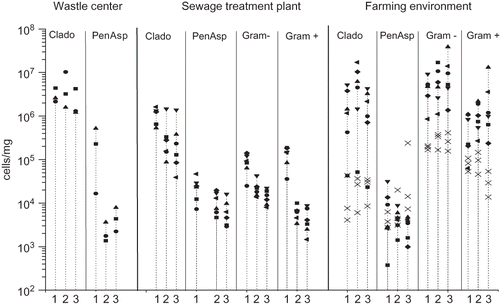Corrigendum
In Volume 61, Number 12 of the Journal of Air & Waste Management Association, certain figures appeared incorrectly in the article “Concentrations and Diversity of Microbes from Four Local Bioaerosol Emission Sources in Finland” by Pasi Kaarakainen, Helena Rintala, Teija Meklin, Päivi Kärkkäinen, Anne Hyvärinen, and Aino Nevalainen, pages 1382–1392. The figures appear correctly below.
Figure 1. Microbial concentrations within and in the vicinity of the waste centre as determined by qPCR analyses. The columns represent geometric mean concentrations and 95% confidence intervals of three measurements at each site. The sampling sites were next to the composting windrows, on the dumping ground and in the nearby population center. Notes: Clado¼Cladosporium spp.; Cherb¼Cladosporium herbarum; Cclad1¼Cladosporium cladosporioides; PenAsp¼Penicillium/Aspergillus/Paecilomyces variotii; Afumi¼Aspergillus fumigatus/Neosartorya fischeri; Anigr¼ Aspergillus niger/awamori/foetidus/phoenicis; Pbrev¼ Penicillium brevicompactum/stoloniferum; Pchry¼ Penicillium chrysogenum; Pvarb2¼Penicillium variabile; Apull¼Aureobasidium pullulans; Eamst¼Eurotium amstelodami/chevalieri/herbariorum/rubrum/repens; Enigr¼Epicoccumnigrum; Wsebi¼Wallemia sebi; Strepto¼Streptomyces spp.
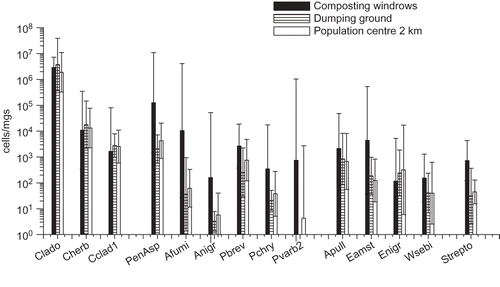
Figure 2. Total concentration of viable bacteria and fungi in three sampling points downwind from the emission source. The columns represent the geometric mean of 2–10 measurements with an Andersen six-stage impactor. Sampling point 1 (black column) is next to the emission source and 2 and 3 as increasing distances. In the waste center area, sampling point 1 is in next to the composting windrows, sampling point 2 in perimeter of the dumping ground, and sampling point 3 in a population center. *P < 0.05; **P < 0.01.
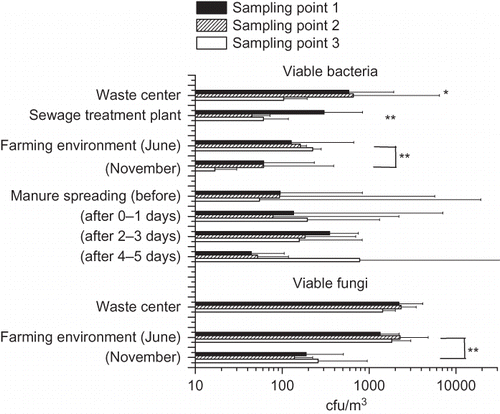
Figure 3. Microbial concentrations in the sewage treatment plant area and in the nearby population center determined with qPCR. Geometric mean concentrations and 95% confidence intervals of 6 samples at each site are presented. For qPCR assay abbreviations, see *P<0.05; **P<0.01.
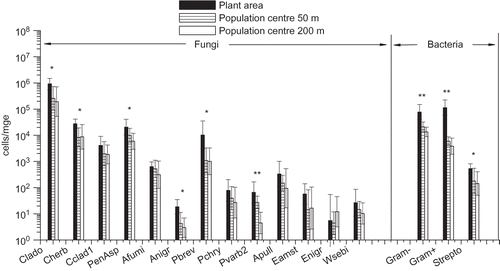
Figure 5. Concentrations of fungi and bacteria before, during, and 1–5 days after cattle manure spreading in three prevailing downwind distances from the spreading area, determined with qPCR. The four columns in a group represent the four sampling times; from left to right: before, 0–1 days after, 1–3 days after, and 3–5 days after manure spreading. For qPCR assay abbreviations, see
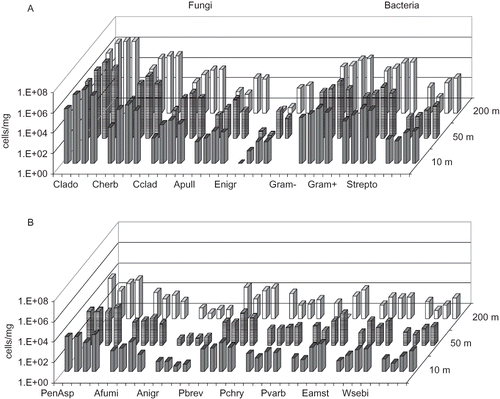
Figure 6. Daily variation in the concentrations of Cladosporium spp. (Clado), Penicillium/Aspergillus/P. variotii group (PenAsp), and Gram-positive and -negative bacteria measured with qPCR. Different symbols in the vertical lines illustrate the concentrations measured on each individual day. The numbers (1–3) in the x-axis represent the three distances from the emission source. In the farming environment, the concentrations measured in November are marked with a cross (×).
